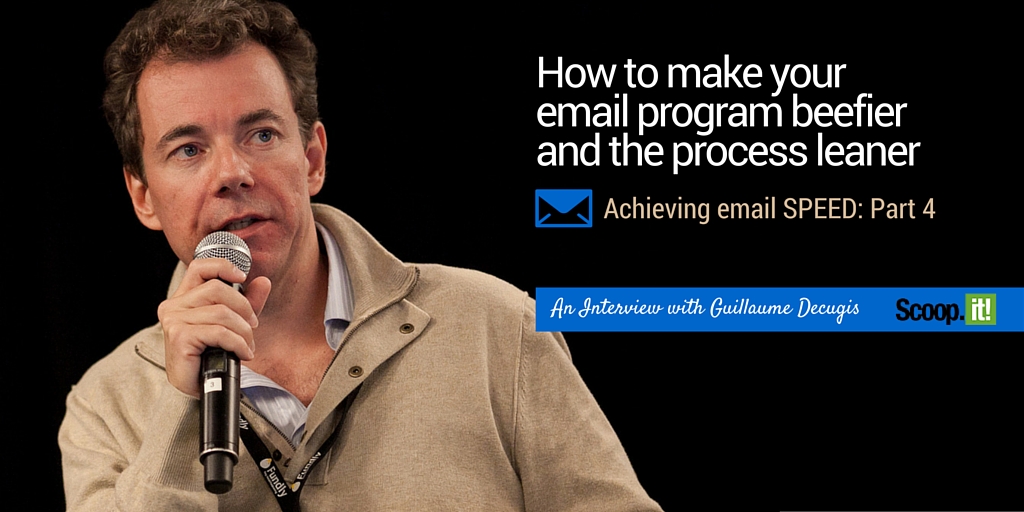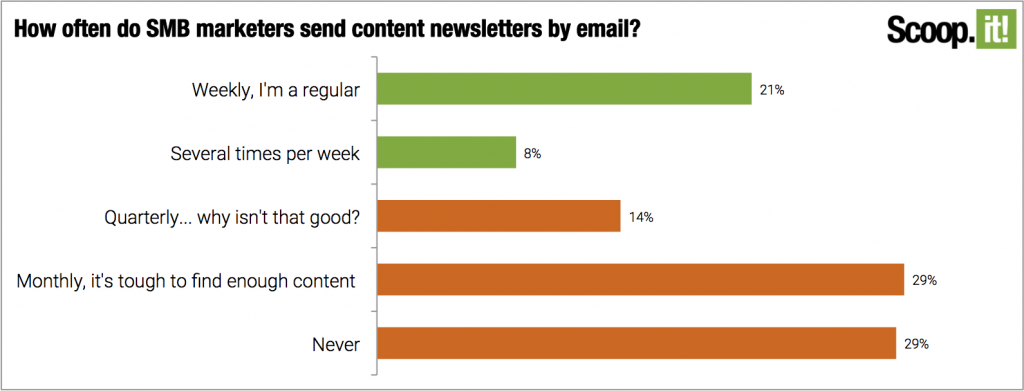
It’s that time again.
We began this email SPEED series by covering how to get started. Second, how to build a list. Third, effective lead nurturing strategies – including email newsletters.
For the next installment, we’re going to focus on how to crank up your email program.
Is it worth it? Will it devour my time and money? Where does the content come from?
These are all valid questions, so I recently consulted Scoop.it‘s CEO Guillaume Decugis for some answers. Guillaume is a man who not only lives and breathes email marketing and the wider universe of content marketing, but he’s also a determined individual on a mission to discover ways to do them more effectively and efficiently.
Should you double down on email?
Barry: In 2014 you took a hard look at two years of your company’s email efforts and published your findings. What was the most important thing you learned?
Guillaume: I was expecting to find some data points revealing whether or not it’s more effective to send newsletters out on a Tuesday or Thursday, what time of day works best, etc.
We found some interesting results, but the number one success driver for us was when we shifted from two newsletters per month to one newsletter a week by using more curated content in those email newsletters.
Many marketers today agonize over the best days and times of the week to send their emails. They struggle with whether or not to use numbers in their subject lines, for example, or spend too much time consumed by elements of their email marketing processes that are in reality very marginal when compared with simply sending out more newsletters — without being spammy.
“Without being spammy” is a very important part of what I’m saying. The reason we succeeded in transitioning from two newsletters a month to one a week is because we don’t distribute promotional content. We steer away from messaging that over-focuses on our own product, and we refrain from flooding people’s inboxes with promotions and discount offerings. Rather, we send out high-quality educational content that is a mix of our own content and curated content.
We found that doubling the frequency of our newsletters was the number one factor for increasing reach, traffic generation and lead generation.

You may have thought that doubling the frequency of email newsletters would have negatively affected open rates. Scoop.it’s study of its own email engagement rates proved the opposite.
Do small businesses doubt the power of email?
Barry: Late last year you created the Scoop.it Content Marketing Grader. It was a very clever double whammy in my mind because (1) you gave your audience a very useful tool and (2) you produced remarkably insightful data regarding content marketing best practices as a result.
The Content Marketing Grader included a question about email frequency and your data shocks me. You found that 72% (the orange bars above) send email newsletters quarterly, monthly or never. What’s your take-away?
Guillaume: Email is very underutilized. Only one-in-four SMB marketers sends email newsletters weekly or more. And to me, in any industry, it’s easy to justify a weekly roundup of great content.
We tried to learn why by talking to a lot of marketers who participated in our ROI grader. I gathered there is a history with email: it’s kind of old and marketing email has been associated with spam because we started getting spammed 15 or more years ago. A considerable amount of focus was placed on promotions in the first generation of email marketing – specifically eCommerce types of promotions.
I think most marketers grasp the extent of the problem. They don’t want to spam their users so they are wary of sending out email more frequently. But at the same time, they’ll blog more frequently. There really is no good reason for that.
What more people need to understand is that with content marketing, the focus shifts from promotional content to more educational, informative, or entertaining content. If you distribute content your audience finds valuable, they’re going to ask you to send it more often.
For whatever reason, marketers have a different quality threshold for what to publish on their blog vs. what to send in newsletters, which I think is a misguided way to look at it.
Can the email creation process be made less cumbersome?
Barry: If you buy into the idea you should send more email newsletters to prospects and customers who want it, the obvious next question is “how?” Many marketers find the email creation process to be extremely cumbersome.
I know email functionality is built into your Content Director product. What were your objectives when you began developing an email solution?
Guillaume: We built an email editor based on the premise that we have to give SMB marketers an easy way to create newsletters frequently and with high quality content.
You can’t solve any problem just by having more content. It needs to be good content.
There are a few things we deliver in our products. One is we help with content curation. Many SMB marketers struggle with publishing enough content to have a robust weekly newsletter. So we tell them you can supplement your own original content with two, three, or four pieces of curated content.
If you write one blog post a week and are having trouble putting together enough content for a weekly newsletter, we provide you with a way to use curated content to supplement the post with curated pieces. There you go; you can increase the frequency just by doing that.
The second thing we provide is an email editor that’s fully drag-and-drop. It takes ten minutes to place content—homemade or curated—and package it into a beautiful looking email.
These elements work to help with your productivity on two levels. You supplement your original content with curated content and you cut the three or four hours it usually takes to format and make emails look beautiful down to ten or fifteen minutes.
The above GIF shows how you can create a newsletter in less than 10 minutes in Scoop.it Content Director by drag and dropping the articles you’d like and previewing the final result.
But isn’t content curation a major time suck?
Barry: How do you help the SMB marketer find stories to send?
Guillaume: Scoop.it products have a content curation engine. You enter keywords to describe the content your audience is interested in. It can be a single word, a combination of words, or multiple keywords, and you can refine the process extensively.
Then the technology is going to crawl the web to find content that matches the keywords that we think is quality content. It comes to the user in the form of content suggestions. Our technology crawls more than 30-million web pages every day, so we automate the discovery process.
You don’t have to search for your content. You sift through the suggestions, find the content you like, and then publish it on your blog, on social channels, and your email newsletters.
Barry: Where does the email service provider enter into the process?
Guillaume: Email service providers focus on solving problems such as distributing email to large groups, connecting with internet service providers, and getting whitelisted. In other words, they deal with the distribution more than anything else.
We don’t distribute the email. We focus on the email creation process itself. Typically the email service providers haven’t been really good at this.
Scoop.it works with email service providers—like MailChimp, for instance, whom we have a direct integration with—and the more sophisticated marketing automation platforms like HubSpot or Marketo.
We’re focused on the content marketing element of the email and because we focus on that we’re able to speed up the process and make it super-efficient. Users export the content into MailChimp or Marketo or HubSpot and use the platforms for the distribution. So that combination is really working well.
How do you know it works?
Barry: Another thing SMBs get from email service providers (ESP) is analytics. Does Scoop.it add anything to the party when it comes to analyzing email?
Guillaume: Absolutely. Your ESP typically gives you open rates, click rates, location and a bunch of things related to the email itself, but we add value elsewhere. We help you track your content performance based on the goals in your content marketing strategy…traffic generation, social media engagement… and—what we think is most important—lead generation.
The Scoop.it platform gives you stats that your email service provider cannot give you, which indicate whether or not the content you distributed via email did or did not help convert visitors into potential leads.
If you’re a marketer, you’re going to have to ultimately justify your marketing investment by helping the business through generating leads. We have those analytics built into Scoop.it Content Director to help you understand exactly how each and every piece of content you publish to your blog and distribute by email is helping convert visitors into leads.
The ROI question at the end of the day should be does my content perform and does it help my business?
All done?
Nope. Stay tuned for the fifth and final edition of our Email SPEED series.
Next up: email analytics. We’ll explain how to measure and improve your email marketing and give you a closer look at our recipe for analytics to help you create more effective content and realize greater conversion.
If you want to get 30 effective techniques to master content marketing along with valuable insights from 10+ influencers like Mark Schaefer, Rebecca Lieb, Lee Odden, Jason Miller or Ian Cleary, download our free eBook now!




